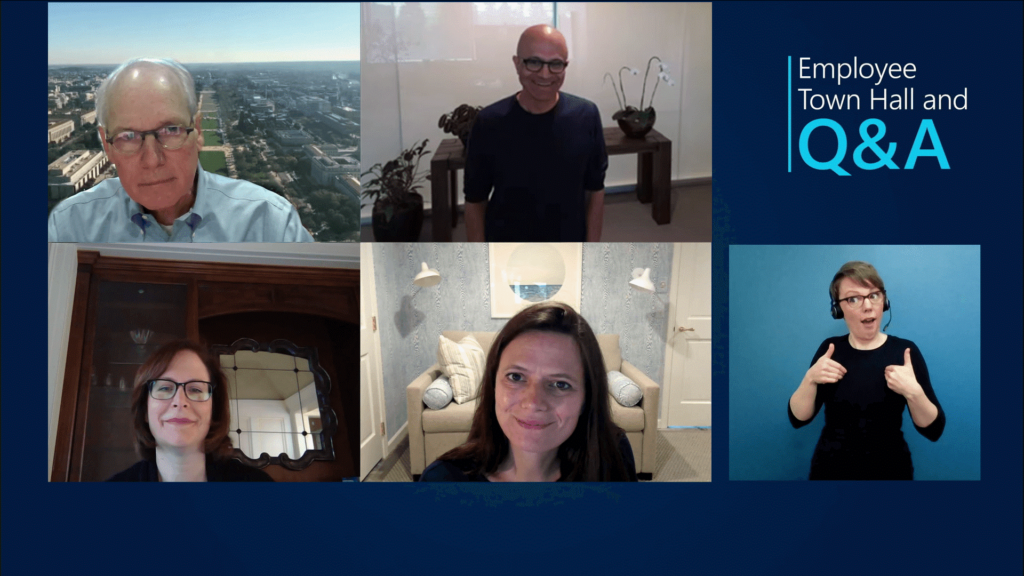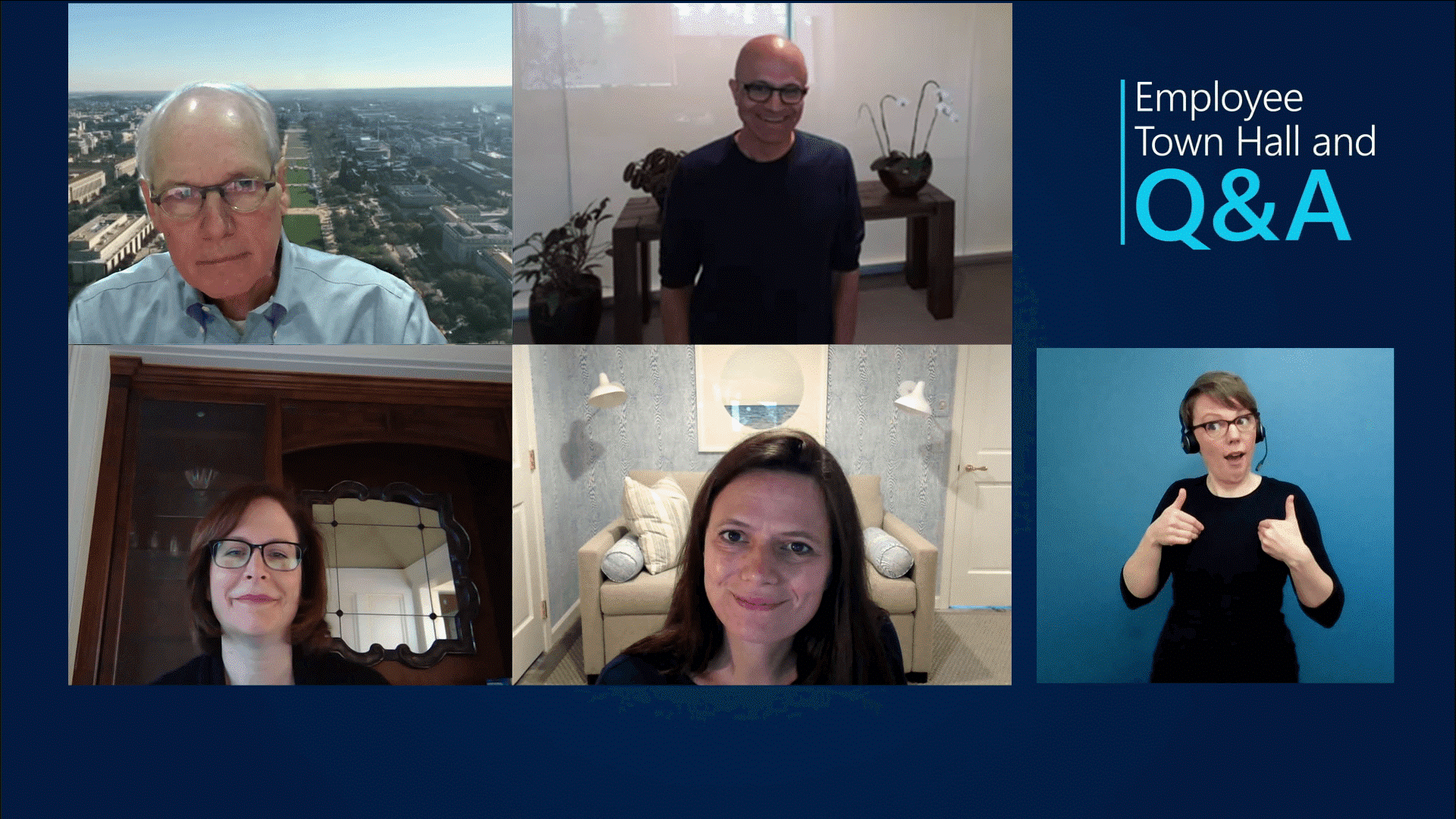
How leaders can bring employees together during COVID-19
Recently, Microsoft leaders held our first employee town hall since moving the entire company to remote work back in March. Spread across the world, our 151,000 employees are accustomed to digital town halls with CEO Satya Nadella and other leaders. The difference this time: all 17 participants, along with the production team, tuned in digitally as well. I was one of those 17 participants, and I was so excited both to connect with my colleagues in this new way and to see how our technology held up to the challenge. Read on for the full story—I hope you find it helpful as you bring your own organization together in this era of remote everything.
Microsoft’s senior leaders bring employees together during COVID-19
April 22, 2020 | Lukas Velush
Microsoft CEO Satya Nadella and members of the Microsoft Senior Leadership Team meet with employees virtually during the company’s first Employee Town Hall and Q&A held during COVID-19.
Microsoft CEO Satya Nadella and his leadership team wanted to bring Microsoft together after asking company employees to work from home in response to COVID-19.
“We wanted to be able to bring everyone together virtually in a way that would allow our leaders to share their thoughts with employees, but also to address many of the hard questions that we knew employees were asking,” says John Cirone, director of employee communications at Microsoft. “We wanted to share a moment where we could talk about how we were mobilizing our response to COVID-19 across our employees, customers, and our communities.”
Normally company leaders meet with employees once a month for an Employee Town Hall and Q&A. They typically gather in a café somewhere on Microsoft’s campus in Redmond, Washington. Though several hundred employees gather in the room, the meetings are primarily virtual. Microsoft Production Studios uses live events in Microsoft 365 to broadcast the town halls to the company’s 151,000 employees. People attend the event in Yammer, where they can engage and ask leaders the questions that drive the Q&A. After the event, people can catch up with the event recording and search for specific moments in the automatically generated transcript and table of contents in Stream.
“We use these meetings to have a reoccurring dialogue with our employees that centers around the company’s mission, its aspire-to culture, and its strategy,” Cirone says. “Our employees can watch from anywhere in the world live or on-demand. The CEO and the leadership team share their top-of-mind thoughts, give their insights on recent company news, and answer questions that employees have. We hold these events every month, regardless of key company-news moments, as the goal is to engage in a continuous dialogue—that’s really the key, it’s about ongoing leader and employee engagement in a way that allows our leaders to be personal at scale.”
Turning to live events in Microsoft 365
When it came to the March employee Q&A, stay-at-home-measures meant that company leaders would not be able to gather in one space for the event. And while the live-events platform would allow the CEO to virtually broadcast to employees, additional steps would be needed to support the Senior Leadership Team’s goal of joining virtually for the broadcast.
That created a challenge that the team needed to overcome.
“One of the event principles is that both the CEO and his leadership team gather together to talk directly with employees during these events.,” Cirone says. “They are always there in the room or on-camera, responding together to the questions that come up.”
Once it became clear how important it was to have the full leadership team come together virtually, the Microsoft Employee Communications and Microsoft Production Studios teams partnered with the Microsoft 365 product group to find a solution.
How did they solve the remote working challenge?
“What we came up with is having them all join a Microsoft Teams meeting and broadcasting that meeting to the entire company as a live event,” says John Schoonover, manager of Facility and Production Solutions at Microsoft Production Studios. “That way they could talk with each other and answer questions from employees very naturally—they meet on Microsoft Teams all the time. And on the audience side, employees could see them interacting with each other and could ask them questions on Yammer.”
How did it go?
“The technology worked great,” says Schoonover, who says his desire to be in control of the show flow was tested. “We had a few production challenges that we had to work out.”
Those challenges had to do with managing a meeting with 17 participants reporting in from locations that he didn’t control.
“The cameras, the microphones, the lighting, their bandwidth—everything was in their homes and out of our reach,” Schoonover says. “It’s unsettling any time you don’t have full control over a production. We had some nervousness over having the best possible experience for our participants and for the audience.”
Guidelines were shared. Advice was given. The leadership team was asked to join the meeting a few minutes early, giving Schoonover and his team a chance to quickly review each person’s setup. How did they sound? Was the lighting adequate? Were they the right distance from their camera? Would they please remember to go on and off mute at the right time?
“It absolutely went smoothly,” Schoonover says. “There were a couple of times when someone’s bandwidth became an issue and their image froze up—we had a still image of them ready to go and we were able to switch over to it when that occurred.”
The other major challenge Schoonover’s team faced was managing the event flow—who would speak when and whose face should appear on the Teams interface that the audience was seeing. They were helped greatly by a new feature in Teams (soon to be released publicly) that allows more than four people to be shown on the meeting interface at once.
They needed the added flexibility because they didn’t know which of the 17 leaders was going to speak next.
“The Teams meeting was technically in control,” he says. “It did all the camera switching that we would normally do in a production-room environment—Teams essentially switched to whoever was speaking and whoever had their mic open.”
That automatic switching was a good thing because it made the conversation feel more natural, Schoonover says. It did, however, make it hard for the team to show alternative views, like going full-screen on someone who was talking.
The solution for that was to use the pinning feature in Teams—when someone started speaking in-depth on a topic, the production team would pin their camera feed across the whole screen on a different PC and would use their production-room controller to switch to that view while they spoke. When the speaker was wrapping up, the production team would switch back to the main PC showing the CEO and several other leaders listening.
“That allowed us to switch back and forth between different views like we would during a normal broadcast,” Schoonover says. “It also allowed Satya to control the flow of the meeting—a moderator would read questions coming in from employees on Yammer, he would give his input, and, when needed, he would call on a leader to provide more detail.”
The team used a dedicated PC to pin the event’s sign-language interpreter on-screen for the duration of the Q&A, which allowed them to continuously pipe her into the broadcast no matter which view they switched to.
“I was pleased with how smoothly things went and with how authentic it was,” says Schoonover, who called out Teams’ automatic camera switching as a highlight. “It felt very organic, very natural.”
Cirone agreed, adding that another highlight was that employees got to peek into the homes of the company’s leaders.
“There was something that was very authentic and real about that,” he says. There was some teasing about the libraries and other backgrounds that the leaders were showing—a few were showing alternative backgrounds, a new feature in Teams.
It was all about bringing everyone together. “There’s something very humbling and unifying about how this is happening to all of us, that we‘re all going through this together,” Cirone says.
Delivering the Q&A to employees
Once Schoonover’s team wove the elements of the production together, his team handed it off to the second half of the Microsoft Production Studios, the part of the house responsible for patching the live feed into Yammer. There, employees watched, asked questions, and interacted with each other before, during, and after the event.
“For us, having this be a remote Microsoft Teams meeting didn’t change anything,” says Jeff Tyler, a digital media experience lead for Microsoft Production Studios. “At the end of the day, what came out of our production switching room was the same as always—the only difference was where people were presenting from.”
The team did all of things it normally does, including adding real-time captioning, watching for video lagging, and getting ready to make the session ready for on-demand viewing once the event was complete, says Kristyona Rosin, a webcast and transmission team lead for RUN Studios, the vendor company that supports Microsoft Production Studios.
“We were very prepared for a larger-than-normal audience,” Rosin says. “We normally have about 10,000 employees online during a Q&A, and this time we had more than 22,000, which was a record. Another 13,000 employees watched a video-only live stream.” The event recording was then available to watch on-demand for employees who missed the live show—more than 15,000 employees watched on demand.
Cirone says employees reacted positively to the meeting.
“We had more engagement than we’ve ever had on Yammer,” he says. “Employees asked lots of good questions about the company, about how we’re all working from home, about our role in the crisis, and asking what they could do to help. They were having a lot of interesting and supportive conversations with each other.”
Going forward, Microsoft’s leadership team will continue to use the live events platform to meet and engage with employees for as long as working from home is needed, Cirone says. And Microsoft is continuing to build in new features and experiences to help remote-working employees and customers everywhere connect through live events.
Here are some resources to get started with live events in Microsoft 365 at your company:
- Get a primer on getting started on live events.
- Watch this live events primer video.
- Go here to get a detailed overview of live events.
- Get assistance running your live event.
- Go here for a primer on how admins can get started with both Microsoft Teams and live events meetings.
Here are additional resources to learn more about how Microsoft uses live events internally:
- Learn more about how leaders across Microsoft are using live events in Microsoft 365 to connect with their teams.
- Read this case study on how Microsoft uses live events in Microsoft 365.
- Learn how Microsoft used the live events platform to hold a key global meeting.
- Watch Microsoft’s IT experts talk about how they migrated to live events in Microsoft 365 from Skype Meeting Broadcast.

